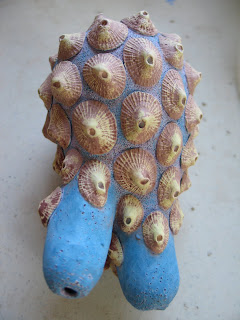In graduate school I gained access to a much more impressive venue for papermaking. UW-Madison had a papermill and occasionally Jim Escalante would teach papermaking classes. It wasn't the most popular medium and I often worked in the studio alone during the time I experimented with paper as a sculpture medium. I was accustomed to working with clay and, for sculpting, clay has some serious advantages over paper. Clay acts as its own support structure, for one. With paper pulp I needed to either form the wet paper over a mold and let it dry or build it onto a wire mesh structure. Though I liked the texture I could achieve with paper (and I liked how light the paper was to transport) I wasn't as happy with the forms I could make.
detail of an installation of handmade paper and fabric sculptures (2005)
I returned to clay as my primary medium and the works for MFA show were exclusively made of clay with just a few pieces incorporating other media such as hair (and metal or fishing line for hanging or support).
One of the things I like to explore in my ceramic work, however, is the contrasting of textures. I can achieve this contrast in clay itself by the use of different molds, textures, applied sprigs or burnishing techniques. I can use glaze to create contrasting smooth, shiny and matte or satin finishes as well. I have experimented minimally with incorporating other materials such as hair or mulberry paper.
high fire ceramic with synthetic hair (2006-MFA Exhibtion)
low fire ceramic with mulberry paper (2010)
I was pretty happy with the results of the mulberry paper and have decided to experiment with this material more this summer. the process is somewhat tedious (like much of my work) but I like the results.
In working this way, I was also reminded of my use of hair several years ago and, though I haven't allowed space to incorporate hair or other materials in much of my work this summer, I would like to keep this technique in mind for future work.
Besides my own work, I have had two recent outside reminders of incorporating mixed media. In the Spring I had a independent student who was working with polymer clay in a steampunk style. She incorporated clock gears, light bulbs and other machinery or pieces of metal into her work both before and after baking (polymer clay is baked to a much lower temperature than regular clay). A few years back I had a couple of students who incorporated crushed marbles into their fired clay. And just a few weeks ago I was looking at Renee Adams' work at the Tieton 10 x 10 x 10 exhibition and admiring her incorporation of polymer clay, flocking and other materials to create contrasting surface textures.
Two other long time influences incorporate contrasting materials and have a tactile quality that I find appealing. I first saw Jason Briggs' work at an exhibition in my hometown, Whitewater, WI. He went to University of Wisconsin-Whitewater as an undergraduate and had work in an alumni show. Later I discovered that my parents owned a vessel he had made as an undergraduate. (The most interesting features of the vessel: an unusually textured glaze and an attached glass marble.) Briggs' work is highly textured. He incorporates real hair into his work but most amazing are the soft and contrasting textures he is able to achieve with the clay. His pieces sometimes look gross, particularly in photographs but in person they are simply intriguing. You want to look and touch. There is so much to see in each of his pieces. I took my daughter to see his work at the last NCECA (National Council on Education for the Ceramic Arts) convention and she just wanted to look and look. (I often think the opinions of the very young are more pure than adult reactions).
Michael Barnes is a printmaker, but his subjects often seem to incorporate pieces that don't belong together. He seems to be making prints of sculptures made of mixed media. His lithographs have a soft, inviting texture that makes me want to touch the objects inside the images.






















































